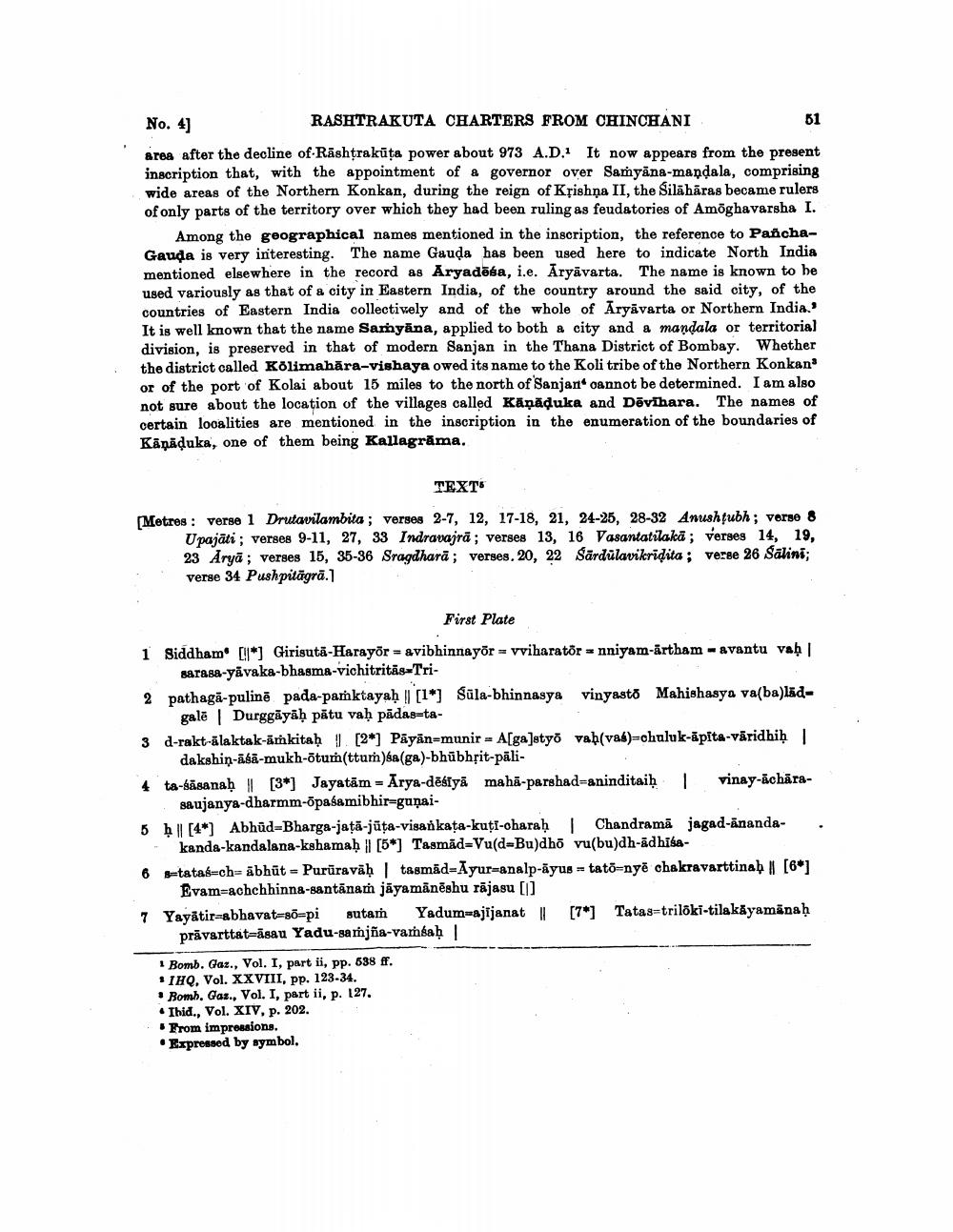________________
No. 4]
RASHTRAKUTA CHARTERS FROM CHINCHANI
area after the decline of Rashtrakuta power about 973 A.D.1 It now appears from the present inscription that, with the appointment of a governor over Samyana-mandala, comprising wide areas of the Northern Konkan, during the reign of Krishna II, the Silahāras became rulers of only parts of the territory over which they had been ruling as feudatories of Amōghavarsha I.
Among the geographical names mentioned in the inscription, the reference to PanchaGauda is very interesting. The name Gauda has been used here to indicate North India mentioned elsewhere in the record as Aryadesa, i.e. Aryavarta. The name is known to be used variously as that of a city in Eastern India, of the country around the said city, of the countries of Eastern India collectively and of the whole of Aryavarta or Northern India." It is well known that the name Samyana, applied to both a city and a mandala or territorial division, is preserved in that of modern Sanjan in the Thana District of Bombay. Whether the district called Kōlimahāra-vishaya owed its name to the Koli tribe of the Northern Konkan or of the port of Kolai about 15 miles to the north of Sanjan cannot be determined. I am also not sure about the location of the villages called Kanaduka and Devihara. The names of certain localities are mentioned in the inscription in the enumeration of the boundaries of Kāņaḍuka, one of them being Kallagrāma.
TEXTS
[Metres verse 1 Drutavilambita; verses 2-7, 12, 17-18, 21, 24-25, 28-32 Anushtubh; verse 8 Upajāti; verses 9-11, 27, 33 Indravajra; verses 13, 16 Vasantatilaka; verses 14, 19, 23 Arya; verses 15, 35-36 Sragdhara; verses. 20, 22 Särdülavikriḍita; verse 26 Šalini; verse 34 Pushpitägrā.]
51
First Plate
1 Siddham [*] Girisutä-Harayör avibhinnayōr = vviharatör = nniyam-ärtham avantu vaḥ | sarasa-yavaka-bhasma-vichitritas Tri
2 pathagi-pulina pada-pamktayab [1] Sala-bhinnasya vinyasto Mahishaaya va(ba)läd galē | Durggāyāḥ pātu vaḥ pādas-ta
3 d-rakt-alaktak-ämkitaḥ || [2] Payan-munir = A[ga]styö vah(vas)-chuluk-apita-väridhiḥ | dakshin-asa-mukh-otum(ttum)sa (ga)-bhubhṛit-päli
4 ta-sasanaḥ | [3] Jayatām Arya-dēsiya maha-parshad=aninditaiḥ 1 vinay-ächārasaujanya-dharmm-5palamibhir-gunai
=
5 | [4] Abhūd-Bharga-jaṭā-juta-visan kata-kuți-oharaḥ | Chandrama jagad-änandakanda-kandalana-kshamaḥ || [5] Tasmad-Vu(d-Bu)dho vu(bu)dh-adhisa
6 s-tatas-ch-abhūt = Purüravaḥ | tasmad-Ayur-analp-ayus tato-nye chakravarttinab || [6*] Evam-achchhinna-santānam jāyamānēshu rājasu [|]
7 Yayatir-abhavat-a-pi
sutam Yadum-ajijanat || [7] Tatas-trilōki-tilakayamanaḥ prāvarttat-asau Yadu-samjña-vamśaḥ |
1 Bomb. Gaz., Vol. I, part ii, pp. 538 ff.
IHQ, Vol. XXVIII, pp. 123-34.
Bomb. Gaz., Vol. I, part ii, p. 127.
Ibid., Vol. XIV, p. 202. From impressions. •Expressed by symbol.




